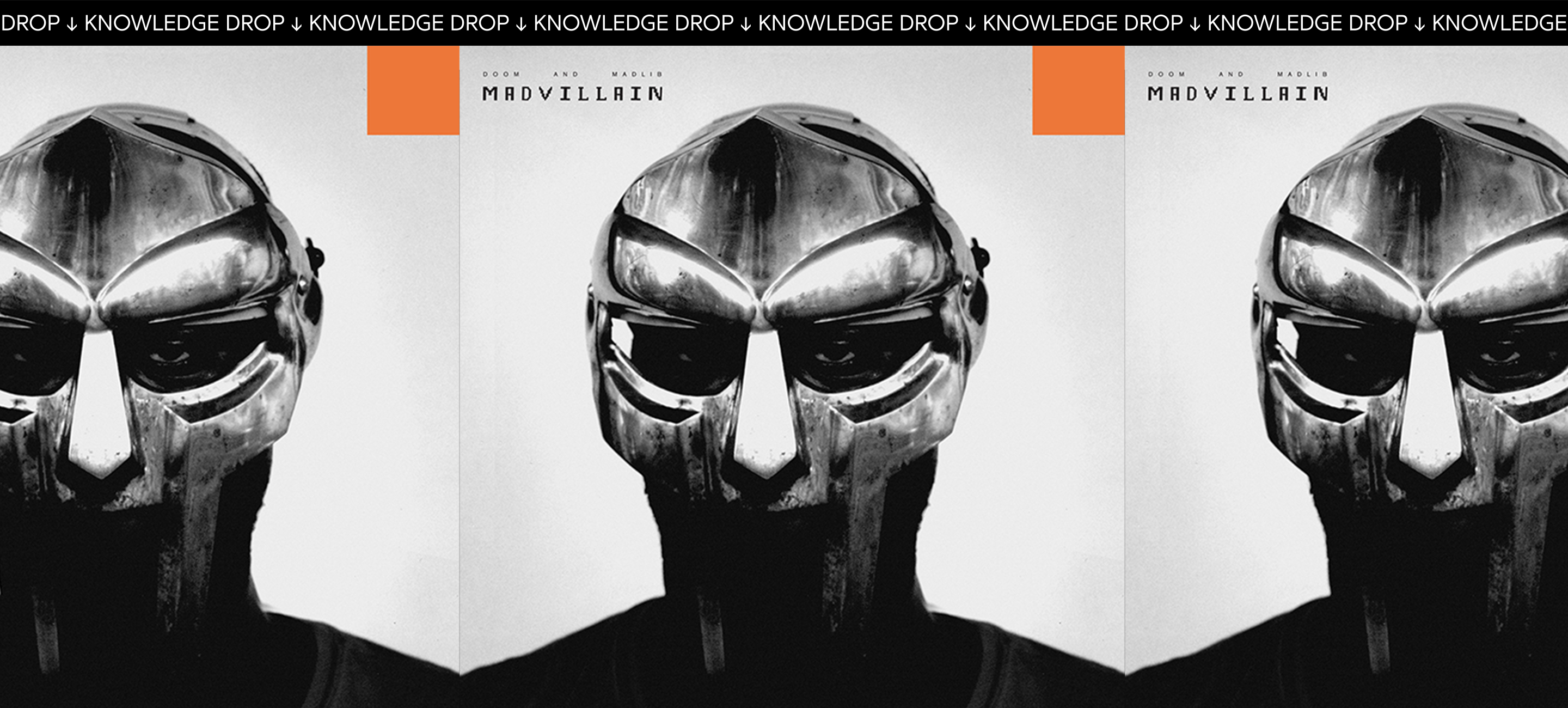Table of Contents Show
MF DOOM and Madlib are widely regarded as two of the most influential figures in experimental hip hop, blurring the lines between the “mainstream” sound and a completely avant-garde style. In the early 2000s, these two artists formed a hip hop duo named Madvillain, known for their eccentric and “underground” musical style. Their debut (and so far only) album, Madvillainy, perfectly blends the witty and loose style of MF DOOM with the muffled, jazzy production of Madlib. This album contains 22 tracks totaling only 46 minutes, revealing the album’s overall goal to convey quick expressions of cleverness and humor within a lyrically dense template. Throughout the project, the duo does not shy away from sidetracking the audience with creative snippets, or cutaways, that slightly interrupt the flow of the album while reinforcing the album’s overall themes of experimentation and blending of unique musical techniques.
Instrumental Cutaways
The variety of instrumentation Madlib inserts on Madvillainy allows for highly effective cutaways while maintaining the musical integrity of the project. Although MF DOOM demands most of the attention from the listener through his lyricism and wordplay, Madlib’s decision to abruptly make instrumental switches throughout the album effectively draws the listener in and out of focus while listening to the tracks. MF DOOM is not present during any of these instrumental deviations; the entire focus is placed on Madlib and his musical selection. In most cases, Madlib prefers a gritty sound, mirroring the dark and hard-hitting style of golden age hip hop. However, in his sampling, there is a level of playfulness. In a few instances, he directly implements raw instrumental fragments with an unorganized feel, without structure in a firm drum pattern or constant tempo, which is usually necessary for traditional hip hop. In Madvillainy, Madlib makes use of both album-specific instrumental cutaways and song-specific instrumental cutaways to establish the “raw” and frivolous qualities of the project.
Album-Oriented Instrumental Cutaways
Madlib produces three instrumental tracks for Madvillainy, which divert the listener’s attention from MF DOOM’s raps for brief one-minute stints. Repetition is a key element in these songs; the loop-based drum patterns, guitar riffs, and basslines establish a firm groove and showcase Madlib’s musical virtuosity. In addition, they may provide the audience a chance to convey their own thoughts while listening to the tracks, and perhaps offer an improvised freestyle over an instrumental, as YouTuber TCtheTopCat did on “Sickfit” while reacting to Madvillainy (( Madvillain-Madvillainy Reaction. YouTube, uploaded by TCtheTopCat. 1 Dec. 2019. )). The tracks “Sickfit,” “Do Not Fire!,” and “Supervillain Theme” provide somewhat muddy yet entertaining cutaways from the album while maintaining the album’s creative tone.

“Sickfit” contains a hard-hitting drum pattern complemented with a deep sub-bass rhythm and runs for a quick one minute and twenty-two seconds. The track acts as an “intense” cutaway following the previous track, “America’s Most Blunted,” in which playful discussions of marijuana provide the track with a level of tomfoolery between MF DOOM and Madlib. In this way, “Sickfit” reintroduces the concept of musical stability within the album, returning Madvillainy to a more established and ordered hip-hop foundation. In addition, the instrumental contains a sample of “Family Affair” by the Generation Gap, giving the track a strong, resonant style (( “Sickfit by Madvillain.” Whosampled.com, 2021. Accessed 16 July 2021. )). Following “Sickfit” is the track “Rainbows,” which has a very loose, open-ended tone, contrasting the determined and ferocious sound of the preceding instrumental.
If “Sickfit” represents the aggressive side of Madlib’s instrumentation on Madvillainy, then the instrumental “Do Not Fire!” symbolizes Madlib’s jumbled and uneven production on the album. “Do Not Fire!” serves as an unsteady cutaway within the project, as it presents two different instrumental excerpts within an even shorter 53-second time frame. The first excerpt has a strong “drunk” feel, including a highly basic drum rhythm layered with obscure melodic phrasing and snippets of “villainous” laughter. The second excerpt contains a slightly altered drum groove with a more “wild” sounding melodic backing while still including devious laughter from the first excerpt (( “Tracks Sampled in Do Not Fire!.” Whosampled.com, 2021. Accessed 16 July 2021. )). This track overall reinforces the “villain” theme Madvillainy strives to achieve while detouring the listener through its obscure and chaotic musical fragments.
The third instrumental cutaway, “Supervillain Theme,” effectively embodies the mischievous personalities of MF DOOM and Madlib on the album. The track contains a sample of the song “Adormeceu” by Brazilian progressive rock band O Terço (( “Supervillain Theme by Madvillain.” Whosampled.com, 2021. Accessed 16. July 2021. )). Madlib slightly speeds up the instrumentation from that track to form the beat on “Supervillain Theme,” which gives the music more “motion” while reminding the listener of the grim feel of Madvillainy. Furthermore, following this 53-second cutaway is the track “All Caps,” in which MF DOOM firmly establishes his influence as a villain and as a ruler throughout his verse. As a result, “Supervillain Theme” can be seen as a preparatory track for the audience, giving them a small “taste” of the villainous wordplay and rhyme schemes that follow in MF DOOMs’ raps.
Song-Oriented Instrumental Cutaways
The track “Accordion” features an addictive and droning accordion loop, providing a steady rhythmic and harmonic backing for MF DOOMs’ rapping. Boasting about his lyrical proficiency and his prominence within the genre of hip hop, MF DOOM maintains that his artistry will never depend on any material wealth, through lyrics such as “Keep your glory, gold, and glitter” (( Madvillain. “Accordion.” Madvillainy, Stones Throw, 2004. )). Maintaining a genuine musicality is the main focus of MF DOOMs’ persona. He references this in his verse before an instrumental cutaway, which leaves the looped accordion playing for two measures before a final four bars from DOOM about his constant dominance on the microphone. This short digression allows him to prepare for his final thoughts on the track. After his verse, Madlib inserts another bizarre, jazzy sample, leading to the next track, “Meat Grinder.” The sample comes from the song “Sleeping in a Jar” by artist Frank Zappa, and its obscure quality adds to Madvillainy‘s already peculiar style (( “Meat Grinder by Madvillain.” Whosampled.com, 2021. Accessed 16 July 2021. )). Sampled vocals such as “The jar is under the bed” offer a petrified and ominous precursor to a similar lyrical barrage that DOOM will deliver in the song.
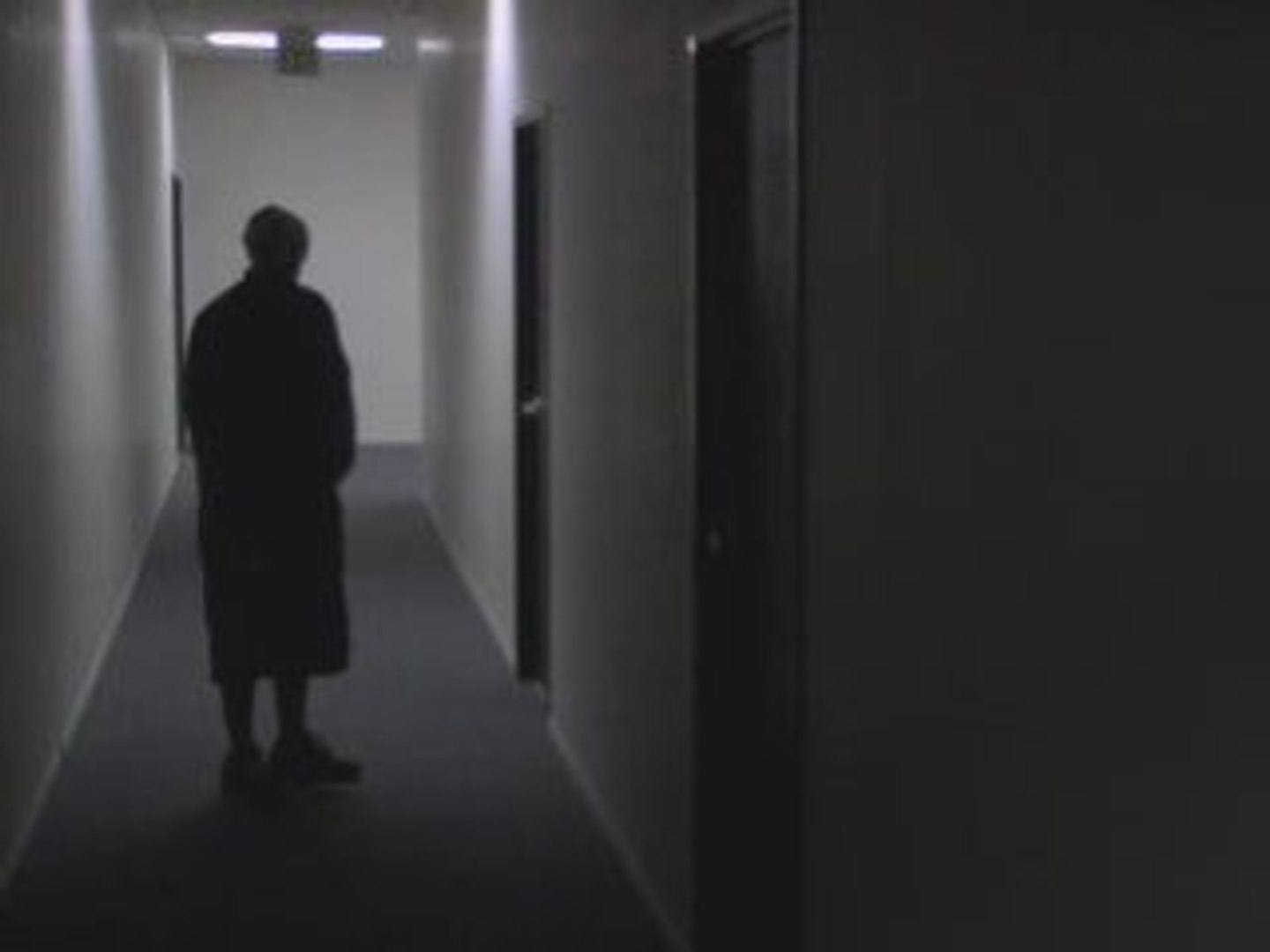
At the beginning of the song “Raid,” Madlib inserts a brief sample of “Nardis” by the Bill Evans Trio, a highly influential jazz standard. Through Evans’s jolty piano-playing, this cutaway gives a succinct introduction to the instrumental that will play throughout “Raid.” In this two-minute and thirty-second song, Madlib samples the 1972 song “América Latina” by Osmar Milito & Quarteto Forma, which serves as the main instrumental for rappers’ DOOM and M.E.D. (( “Raid by Madvillain feat. M.E.D.” Whosampled.com, 2021. Accessed 16 July 2021. )). The song has a very upbeat tempo yet slightly jumbled rhythm, not presenting any structured nor understandable groove for the casual listener. As a result, the initial deviation early in “Raid” through “Nardis” gives a glimpse into the cluttered music that comprises the song.
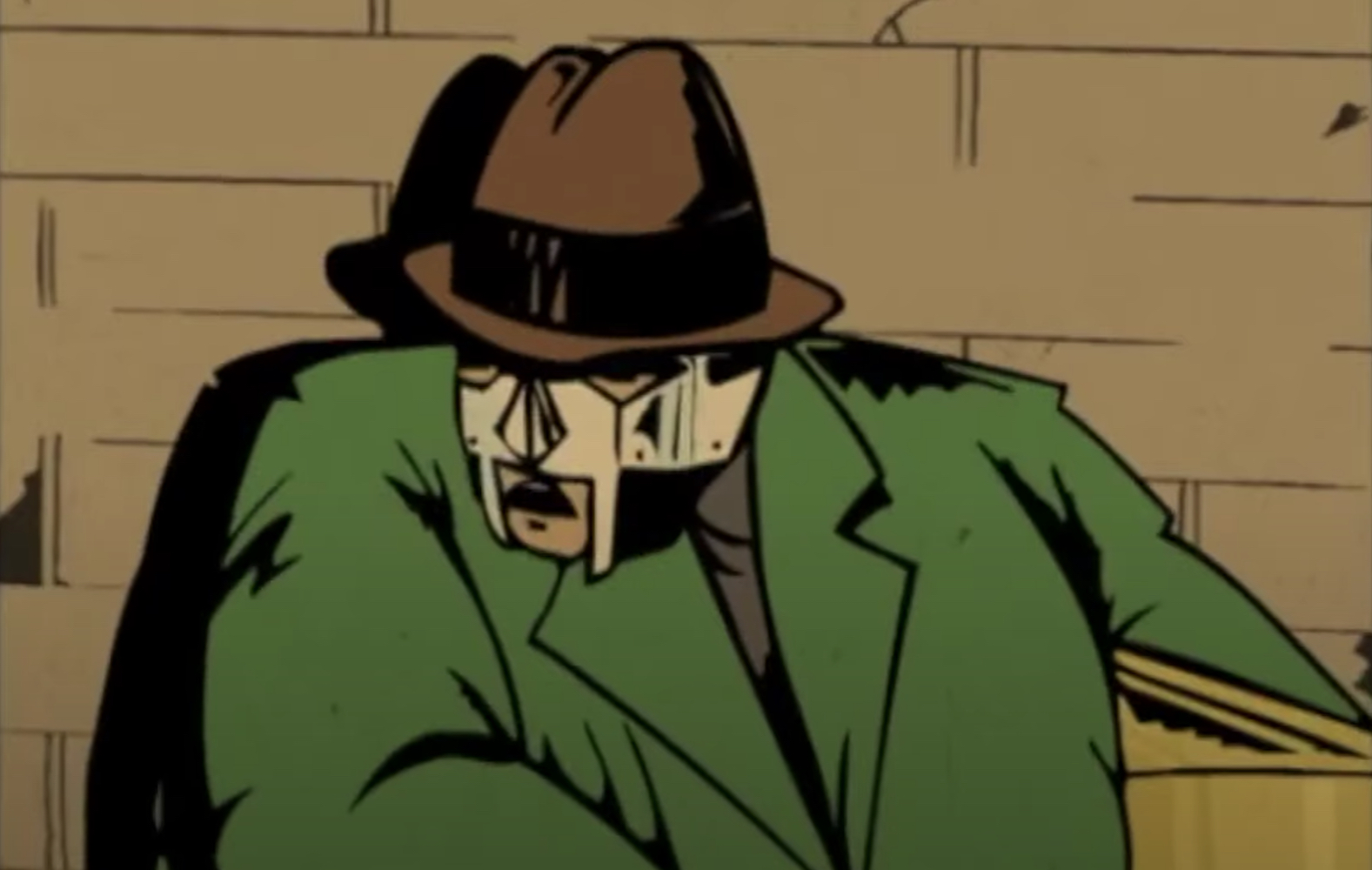
The track “Money Folder” instrumentally features a powerful drum groove with a fierce bassline, providing a vigorous musical backdrop for MF DOOM’s witty lyrics. At the end of his first verse, DOOM mentions Madlib “flipping” (considerably reshaping a sample in hip hop) a jazz standard. Madlib then abruptly inserts a quick 12-second jazz instrumental interlude, which serves as a cutaway from the otherwise serious tone of the track (( “Money Folder by Madvillain.” Whosampled.com, 2021. Accessed 16 July 2021. )). One can view this jazz cutaway as potential comedic relief, providing a brief and clever musical break that takes the listener’s attention away from DOOM’s potent style for a small amount of time. As soon as the interlude ends, DOOM immediately jumps back into rapping about his process of creating verses and insisting that no one can “touch the mic” because no one can match his lyrical prowess.
Madlib diverts the listener at the beginning of the track “Figaro” through a sample of the track “Jeannine” by Lonnie Smith (( “Figaro by Madvillain.” Whosampled.com, 2021. Accessed 16 July 2021. )). The instrumental presents a choppy and rugged organ playing by Smith, which may confuse the listener for a brief moment while preparing them for the main instrumental over which DOOM raps. The main instrumental contains a somewhat uneven guitar loop, matching the loose and unrestrained style of DOOMs’ verse. As a result, the concept of free-flowing musical expression on “Figaro” is initially established through the opening organ cutaway. Furthermore, while the opening instrumental occurs, DOOM takes a deep breath (or Madlib inserts a sample of a deep breath) which symbolizes the preparation needed for performing on this structured yet bumpy beat.
In the track, “All Caps,” one of the more prominent songs from Madvillainy, Madlib positions an adventurous-sounding instrumental towards the end of the song, sidetracking the listener after DOOMs’ verse. This sample comes from an opening credits scene from a 1968 TV show named Ironside (( “Madvillain All Caps.” Whosampled.com, 2021. Accessed 16 July 2021. )). This program was a crime drama, tying into the overall villainous theme of “All Caps” and the album. The instrumental from Ironside follows DOOM’s assertion that he will never “sell out” or limit his artistry but instead maintain his “evil persona” as a rapper. Also, one can note similarities between Madlib’s decision to insert this cutaway and the instrumental cutaway at the end of Kendrick Lamar’s “The Blacker The Berry.” The value of using distinct instrumentation as a digression from the flow of a song is clear in hip hop; it adds another layer of creativity to an already experimental musical foundation.
Vocal Cutaways
In Madvillainy, vocal cutaways, often lead by DOOM’s musical decision-making or Madlib’s insertion of vocal samples, contribute to the creative style of the project and reinforce the duo’s idiosyncrasies. The purpose of including these digressions is to remind the listener of the malicious orientation of Madvillainy, even if they sidetrack MF DOOM’s villainous raps or Madlib’s obscure instrumentals. The opening track, “The Illest Villains,” contains various snippets of dialogue from mid-20th-century drama and horror films (( “Tracks sampled in the Illest Villains.” Whosampled.com, 2021. Accessed 13 July 2021. )). These snippets originate from trailers of Frankenstein (1931), The Wild One (1953), and I Was a Teenage Werewolf (1957), among others. One can view the inclusion of these different dialogues as a precursor to what the audience should expect from Madvillainy. The musical experimentation of MF DOOM and Madlib often results in intentional stylistic digressions, which plays into the project’s mystery.
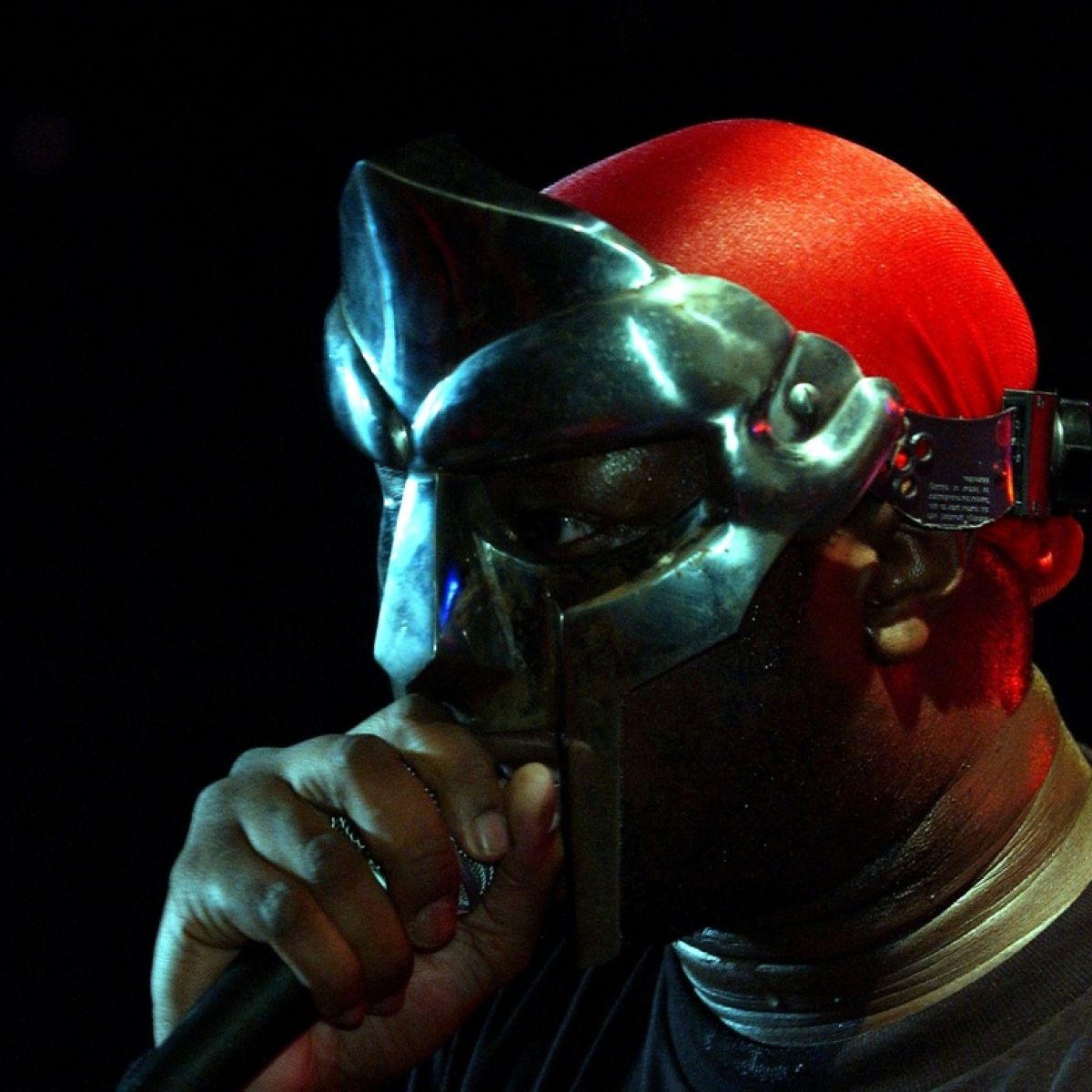
The track “Meat Grinder,” in addition to having an instrumental cutaway, as previously mentioned, contains a very brief vocal interruption by MF DOOM during his raps. As the track begins with the instrumental, DOOM takes a deep breath in, during which the beat cuts out, and then breathes out, at which point the beat resumes (( Madvillain. “Meat Grinder.” Madvillainy, Stones Throw, 2004. )). This very short one-second vocal detour could symbolize the preparation needed for his performance during his verse, which is incredibly dense lyrically and rhythmically. However, it is not entirely clear that DOOM is taking the breath, as it is possible that Madlib inserted a sampled breath or even performed the breathing himself. Regardless, this concise vocal cutaway serves as a reminder of DOOM’s lyrical prowess and the energy needed to achieve it.
MF DOOM directly addresses the audience in the interlude track “Bistro,” which serves as a cutaway to remind them of the comforting environment Madvillainy provides. MF DOOM implements a metaphor to achieve this relaxation by comparing Madvillainy to a cafe, or more specifically the Madvillain Bistro Bed and Breakfast Bar and Grill (( Madvillain. “Bistro.” Madvillainy, Stones Throw, 2004. )). DOOM can be seen as “breaking the fourth wall,” as an acknowledgment of the audience’s existence influences the duo’s art itself, and DOOM highly values their enjoyment of the music. In this way, the creativity and exclusivity of this project are dependent on the support from the fans of Madvillain. The gratitude DOOM expresses on this track momentarily sidetracks the album’s devious and cunning narratives, allowing him to step back and comment on the meaning of his artistic output.
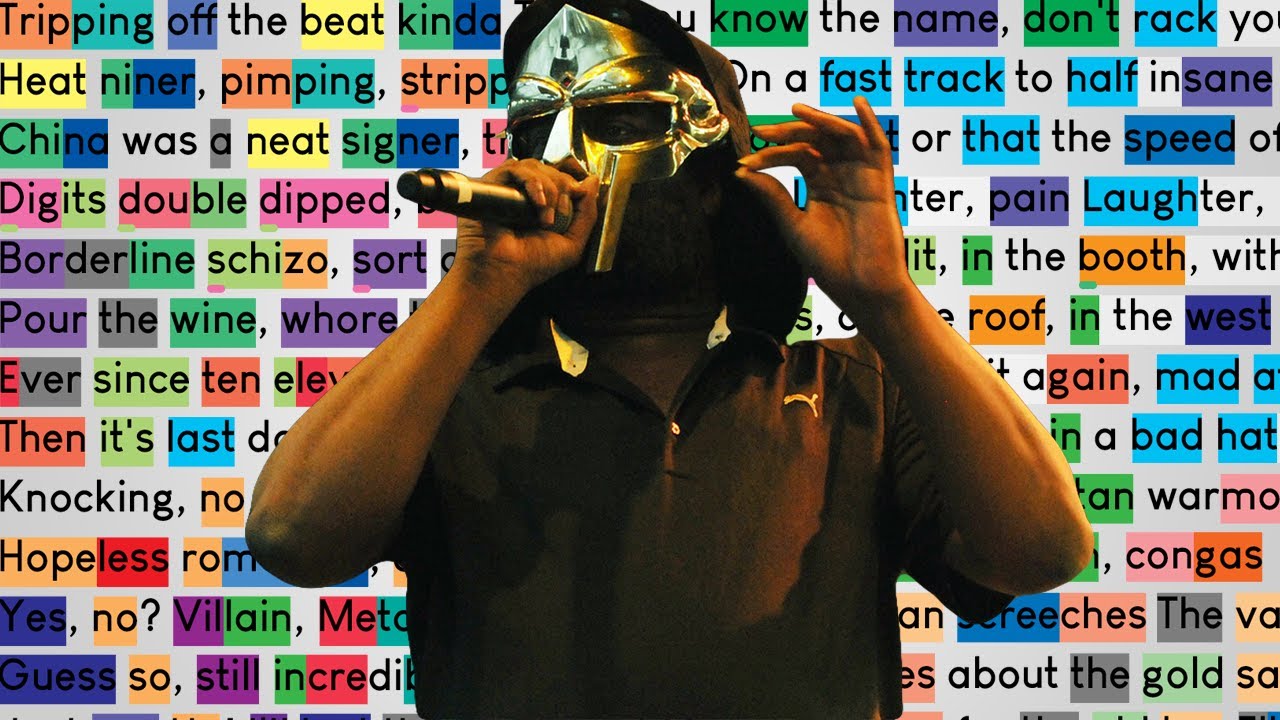
At the end of the track “Money Folder,” Madlib inserts a monologue that describes the essence of Madvillain and the dynamic between himself and MF DOOM. Referencing the production tools Madlib uses on Madvillainy and the wealth MF DOOM has monetarily. In the music that he makes, the monologue serves as a brief reminder of the duo’s “villainous” capabilities in their art. After this commentary, a final vocal sample appears that reinforces its deviousness and demise through a proclamation on the certainty of death (( “Tracks Sampled in Money Folder.” Whosampled.com, 2021. Accessed 16 July 2021. )). This elucidation leads into the philosophical themes of the next track, “Shadows of Tomorrow.” Instead of MF DOOM rapping, Madlib offers two verses, one of which occurs through his alter-ego, Quasimoto. This track overall serves as a lyrical cutaway from DOOM that puts the spotlight on Madlib for a song. Themes of time, life, and death all manifest in his verses, all serving as “metacommentary” for the purpose of his actions as a producer and rapper.
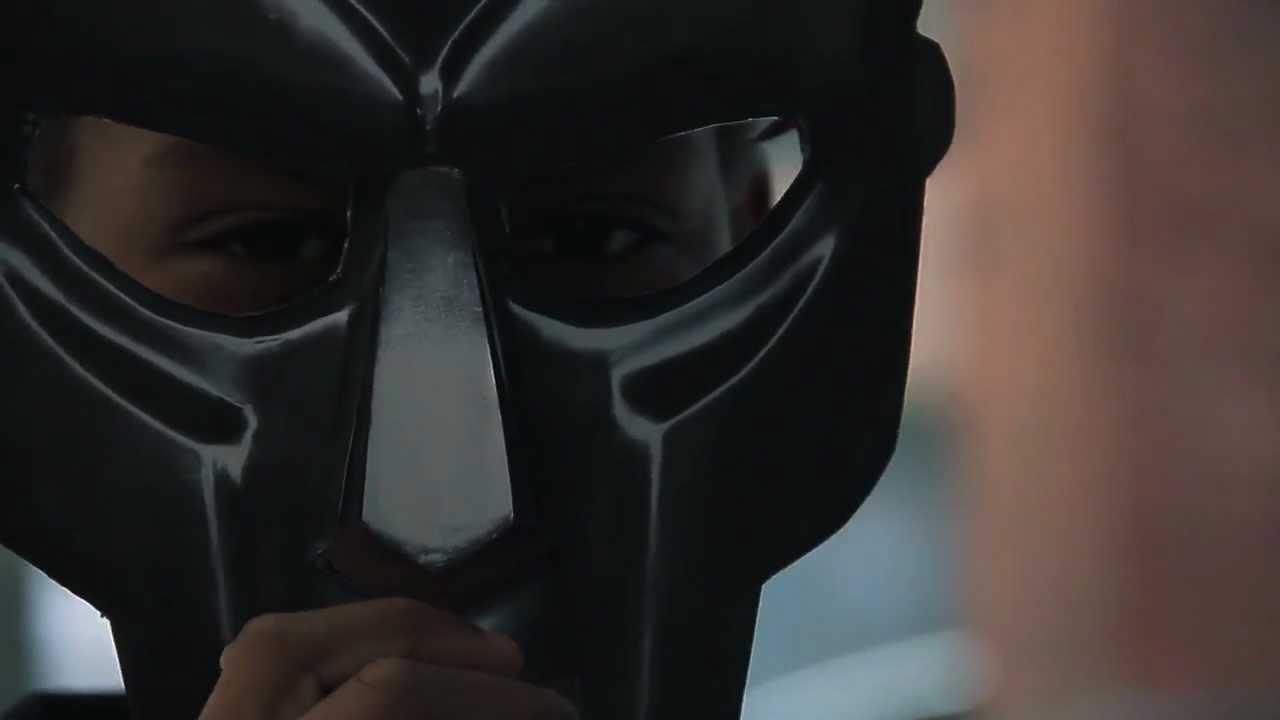
MF DOOM’s politically charged raps on “Strange Ways” reveals a unique perspective on events in the world that transcend the ominous tone of Madvillainy. Commenting on corruption, religion, and warfare, DOOM notes that all of these particular aspects of human society are difficult to change since people inevitably try to fulfill their own desires. After these observations, a final sample discussing relationship troubles symbolizes the overall importance of carrying on in the face of difficulty (( “Strange Ways.” Genius.com, 2021. Accessed 16 July 2021. )). This cutaway represents the value of persistence even if a partner is unfaithful, which applies to the next track, ”Fancy Clown.” DOOM’s alter ego, Viktor Vaughn describes a story in which a girl cheats on him and expresses his desire to confront the man who she sees. At the end of the song, Madlib samples vocals from Phillip Procter and Bergman’s TV Or TV: A Video Vaudeville in Two Tracks (1973) (( “Fancy Clown.” Genius.com, 2021. Accessed 16 July 2021. )). This brief digression from the track addresses the listener directly, asking them to remain patient. The relationship issues that “Strange Ways” and “Fancy Clown” present give Madvillainy a very personal and social tone. Their cutaways cement the kinds of responses necessary to deal with these problems.
Comedic Relief
In a highly experimental and distinctive album such as Madvillainy, comedic relief is bound to happen, underpinning the playful character of the project. These moments of humor detract from the serious and grim tone of Madvillainy and provide new insight into MF DOOM and Madlib’s silliness while crafting music. This is evident on “America’s Most Blunted,” a track that jokes about the use of marijuana. During the track’s outro, Madlib samples Jack Margolis’s 1971 comedy album A Child’s Garden of Grass. Audio from this sample includes the phrase “everyone finds that they’re more creative stoned, than straight” and the incorrect spelling of “marijuana” over the playing of a glockenspiel (( “America’s Most Blunted.” Genius.com, 2021. Accessed 16 July 2021. )). Laughter erupts after this, perfectly symbolizing the comedic orientation of this track and the cutaway. This humorous divergence further enhances Madvillain’s creative flair and showcases their desire to amuse the audience.
MF DOOM decides to sing on the track “Rainbows,” demonstrating a level of comedic relief that breaks from his traditional rapping on Madvillainy. The slow, droning instrumental of the song, along with the hallucination of drinking Drano on the hook, provides a suitable background for his singing. Although the decision to sing might be a humorous attempt to convey his thoughts about the streets and drug use, discussions of handling a “snitch” reinforce DOOM’s mischievous persona. In addition, the outro of the song characterizes his domination and villainous actions, juxtaposing the song’s overall loose and hazy feel (( “Rainbows.” Genius.com, 2021. Accessed 16 July 2021. )). This final cutaway from a track based on comedic relief strengthens Madvillain’s bizarre attempts at providing a comfortable musical environment surrounded by aggressive intentions.
On “Hardcore Hustle,” Madlib inserts comedic relief to reveal the potency of MF DOOM on the microphone. One can hear distressful moaning at the end of the song, perhaps symbolizing the destructive capabilities of his raps. Furthermore, this moaning may be indicative of something more than simple comedy; it may fully embody the true wickedness of Madvillain. The sound of the microphone getting shoved down one’s throat (( “Hardcore Hustle.” Genius.com, 2021. Accessed 16 July 2021. )) reveals a kind of gruesomeness not previously seen in Madvillainy. Discussions of villainy and evil manifest throughout the album, but the inclusion of this vocal snippet of actual harm being inflicted actualizes the viciousness both artists convey in their music.

MF DOOM inserts his own personal self-cutaway on the final track, “Rhinestone Cowboy,” serving as comedic relief from his intention to deliver his best rhyme schemes. Rapping in front of an audience, DOOM feels that he did not offer his best verse, and after his first verse, he denies that he was worthy of applause and asks the crowd to settle down (( “Rhinestone Cowboy.” Genius.com, 2021. Accessed 16 July 2021. )). Self-improvement is necessary for his artistry, and as a result, he delivers a more confident second verse. The brief interlude between verses indicates the desire to improve his craft, even if the art was already tremendously appreciated by his fanbase. One may find it amusing since this self-critique may be based on a repetitive desire to enhance his rapping skills, which his audience may find already developed and in no need for alterations. Madvillainy does not shy away from a display of making strides in the rap game, even with its obscure orientation.
Why the ‘Cutaway’ Influences “Madvillainy”
The notion of a short cutaway from the flow of an album or song is not rare in hip hop, as one can identify an instrumental cutaway in Mos Def’s prominent album Black on Both Sides on the track “May-December.” However, Madvillainy takes this idea to an experimental level, implementing cutaways on the majority of its songs and during the progression of the album as a whole. This decision-making by MF DOOM and Madlib strengthens the villainous theme of Madvillainy because short yet clever interruptions do not allow the listener to feel completely settled while experiencing the project. The obscurity of this album is highlighted when both artists subvert the expectations of the listener by adding odd instrumental clips or muffled vocal samples from old cinema. Although one will expect a bumpy and crude sound while listening to Madvillainy, the wit of both artists is clearly on display, giving the audience something new while not completely “breaking the mold” of familiar rap music.
Throughout Madvillainy, one can note two broad styles of musical “cutaways:” instrumental cutaways and vocal cutaways. As the main producer for this project, Madlib incorporates heavy use of samples, drawing upon audio from 20th-century film and interspersing these sounds throughout the album, giving it a keen “comic book” feel due to its fast-paced structure and its demand for the audience’s excited attention. In addition, Madlib’s inclusion of various instrumental samples adds to the already chaotic musical foundation on which the album rests, giving the project a more layered sound. MF DOOM, throughout the project, vocally contributes to this theme of quick musical digressions by adding his own melodies and phrases that divert the audience from the style of continuous rap. Furthermore, there are elements of comedic relief seen in Madvillainy, where inclusions of humor and wit, completely subverting the audience’s expectations, provide the tracks with a level of relaxation and personableness not visible within the traditional rap scene. Madvillainy, through its constant vocal and instrumental digressions, encapsulates the value of the musical “cutaway” in hip hop.
